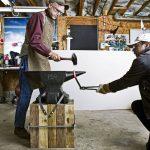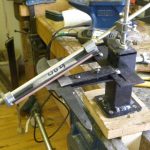The full title of this terrific post is How Japanese Knives Are Made: Behind the Scenes With Master Forgers. It starts with a reasonably extensive primer on the basics of Japanese knives, and after that, it dives deeper into the production process by focusing on the forgers of a distinct cooperative of knifemakers in Echizen, Japan.
From SeriousEats.com
But who makes those knives, and what is the process like? There are several cities in Japan that are famous for their knives, including Sakai (near Kyoto), Seki (in Gifu prefecture), and Echizen (in Fukui prefecture). To see the process firsthand, I visited a Japanese knife factory in Echizen last year. Or, more accurately, I visited eightJapanese knife factories. That’s because I was at the Takefu Knife Village, a consortium of knife-makers who all work in the same facility.
Each of the eight knife-makers runs an independent business—technically, they’re competitors—but they share space and some equipment, and they market their wares both independently and as a group. Plus, it seems, they’re all friends. It’s rare, if not virtually unheard of, to find competing businesses sharing space and resources in the US, but the knife-makers of Echizen have been making it work for centuries.
The city’s history of knife-making, according to the Takefu Knife Village’s website, dates back to the 14th century, when a famed blacksmith from Kyoto visited the area in search of quality water for quenching his steel. While there, he made swords, tools, and knives for the locals, teaching his trade in the process.
For many centuries, Echizen was most famed for its agricultural tools, and at one point was Japan’s leading source of sickles. Though they still make farming tools, as well as scissors, production has largely shifted to kitchen knives. Today, while each manufacturer sells knives under its own name, the collective also takes knife orders from larger companies, which add their own branding to the product before bringing it to market.
The piece is chock full of awesome information effectively presented, yet reads a bit like a documentary motion picture with wonderful photography throughout. I desire to thank reader James for sending this method.


